Once again, I must apologize for taking so long to post new material here! However, this topic comes up with monotonous regularity and the amount of misinformation concerning it is mind-boggling. Here are the results of some testing that we did back in 2009 that may clear up some things for you...
This is not to be argumentative but consider this: You do your testing at 3-5 yards and see if your chosen load is acceptable. If you like it, good. That means that any pellets that miss won't be doing much damage beyond that. Birdshot will almost certainly not OVER-penetrate except at point-blank range.
Since frozen turkeys are so cheap, buy 2 or 3 of them and do the same thing with #4 buckshot and 00 buckshot.
No, I am not trying to convince everyone that #7½ birdshot is the best home defense load by any means, but I surely do NOT believe that 00 buck is either. At least not if you have people in other parts of the house.
Or if you live a trailer park with another trailer right next door.
Or if you live in an apartment or duplex where the neighbor's kid sleeps just 8" away on the other side of that wall.
I think #4 buck or #2 birdshot might be a better choice.
~~~~~~~~~~~~~~~~~
Here is more of the original poster's comments...
About 25 years ago, I shot a coyote that was terribly stricken with mange near San Augustine, TX, from a moving pick-up at about 35 miles an hour with a full-choked 20 ga loaded with Federal Express #6 birdshot. The animal was standing, broad-side, just up from the bar ditch and I was driving down a 2-lane hwy so she was around 40-50' away. A few of the pellets went completely through her and she died instantly. I still have pictures. I shot another one with the same load also from around 40' away. He was sitting facing me and I hit him dead-center chest. He was thrust back on his haunches and died instantly. I didn't do an autopsy to see what the damage was but from the way he died, I'd say his giblets got stirred up pretty well. Does this make #6 birdshot the ideal coyote load? Certainly not but it does kinda give you an idea of the relative effectiveness of small shot in living tissue.
In Liberty,
Cope Reynolds (Desertscout)
Southwest Shooting Authority of Arizona
Listen to Cope live on The Shooting Bench Mon thru Fri, 8 to 9pm Pacific/11pm to midnight Eastern
"The Shooting Bench" Podcast: The Shooting Bench
Colts and Kimbers are what you show your friends.
GLOCKS are what you show your enemies!
*****
Shotgun Ammunition Performance for Home Defense
This began as a response to a guy that had posted his experience shown in the bracketed text below...
[[Originally Posted by Xxxxxx
Just a warning... I just did some running/shooting drills with 20ga birdshot out of a 28" barrel with a modified choke.
Granted, I was shooting 7½ shot, where 6-shot & a 12ga would probably be what you chose...
Still, even at 7 yards where the pattern is only about 2 inches in diameter, the shot only penetrated about 3/8" into a weather-worn 2x6.
I've heard some people say birdshot is the same as buckshot at close ranges... and I don't think it's true.
Xxxxxx]]
After seeing this, I decided to do some testing and posted my results in the same forum...
Seeing how far lead shot goes into a wooden 2x6 at 7 yards tells you approximately how far your shot will penetrate into a 2x6 at 7 yards. I'm not sure that that is a reasonable indicator as to how well the same load will perform in human tissue at the same range. It might offer a little more information to shoot it into something that is flesh and bone. Shoot into a turkey or ham at the same distance and see what you get. By the way, set a doll behind the turkey a couple of feet away for visual effect. You might be surprised.
I realize that 7 yards is pretty standard for testing performance and I generally agree on that but for home defense, well, I don't know for sure. The way my house is arranged, there's only 1 place that I can get a 7 yard shot. 3 to 5 yards would easily be the average.
I realize that 7 yards is pretty standard for testing performance and I generally agree on that but for home defense, well, I don't know for sure. The way my house is arranged, there's only 1 place that I can get a 7 yard shot. 3 to 5 yards would easily be the average.
This is not to be argumentative but consider this: You do your testing at 3-5 yards and see if your chosen load is acceptable. If you like it, good. That means that any pellets that miss won't be doing much damage beyond that. Birdshot will almost certainly not OVER-penetrate except at point-blank range.
Since frozen turkeys are so cheap, buy 2 or 3 of them and do the same thing with #4 buckshot and 00 buckshot.
No, I am not trying to convince everyone that #7½ birdshot is the best home defense load by any means, but I surely do NOT believe that 00 buck is either. At least not if you have people in other parts of the house.
Or if you live a trailer park with another trailer right next door.
Or if you live in an apartment or duplex where the neighbor's kid sleeps just 8" away on the other side of that wall.
I think #4 buck or #2 birdshot might be a better choice.
~~~~~~~~~~~~~~~~~
We went out to the range one morning before we opened and played with the scatterguns a little bit. Pretty interesting. We got it all on video and I'll try to put it on YouTube one of these days. But here's what we found out anyway
I took a couple good-sized, thawed, bone-in pork shoulders approximately 7" thick and put them a pedestal at the customary 7 yards. The first one was shot with the #4 buck and the second with #2 birdshot. The gun was 12 gauge Mossberg 590 with cylinder bore. Without seeing the video, you will never be able to appreciate what we saw but both sizes of shot would be more than adequate. The difference between the two was pretty much indistinguishable. The shoulders both blew up like they had grenades in them. We found pieces of meat as far away as 17 yards forward of the pedestal and 20 yards behind it. Most of the pieces were between the size of a marble and golf ball and they were EVERYWHERE, including the back window of my truck which was 13 yards behind where the meat was. A half dozen pieces were slabs the size of your hand. I will have to review the video in slo-mo to see for sure but we all agreed that the #2 birdshot was more dramatic than the buckshot.
We also shot some 5 gallon jugs of water with #7½ and #2 birdshot; and #4 and 00 buck. The results were pretty inconclusive because the plastic was so thick.
The #7½ caved in the front of the jug a little but only a few of the pellets entered it with zero exiting. The jug tipped up but did not quite fall off the stand.
Quite a few of the #2's entered, zero exits and the energy transferred to the jug knocked it off the stand and about 3' from it.
All of the #4 buck entered, most exited with a few bouncing off the inside of the jug and remaining inside. The distance that the jug was knocked off was virtually identical to the #2 birdshot.
All of the the 00 buck entered and 75% of them exited (these were 12-pellets loads). Three of them bounced off the inside and remained in the jug. The distance that the jug was knocked off was virtually identical to the #2 birdshot.
I bought 4 turkeys the night before to test all 4 sizes of shot but they weren't thawed enough to use the next morning. We left them in the conex out at the range so that we could continue the tests the next day.
I took a couple good-sized, thawed, bone-in pork shoulders approximately 7" thick and put them a pedestal at the customary 7 yards. The first one was shot with the #4 buck and the second with #2 birdshot. The gun was 12 gauge Mossberg 590 with cylinder bore. Without seeing the video, you will never be able to appreciate what we saw but both sizes of shot would be more than adequate. The difference between the two was pretty much indistinguishable. The shoulders both blew up like they had grenades in them. We found pieces of meat as far away as 17 yards forward of the pedestal and 20 yards behind it. Most of the pieces were between the size of a marble and golf ball and they were EVERYWHERE, including the back window of my truck which was 13 yards behind where the meat was. A half dozen pieces were slabs the size of your hand. I will have to review the video in slo-mo to see for sure but we all agreed that the #2 birdshot was more dramatic than the buckshot.
We also shot some 5 gallon jugs of water with #7½ and #2 birdshot; and #4 and 00 buck. The results were pretty inconclusive because the plastic was so thick.
The #7½ caved in the front of the jug a little but only a few of the pellets entered it with zero exiting. The jug tipped up but did not quite fall off the stand.
Quite a few of the #2's entered, zero exits and the energy transferred to the jug knocked it off the stand and about 3' from it.
All of the #4 buck entered, most exited with a few bouncing off the inside of the jug and remaining inside. The distance that the jug was knocked off was virtually identical to the #2 birdshot.
All of the the 00 buck entered and 75% of them exited (these were 12-pellets loads). Three of them bounced off the inside and remained in the jug. The distance that the jug was knocked off was virtually identical to the #2 birdshot.
I bought 4 turkeys the night before to test all 4 sizes of shot but they weren't thawed enough to use the next morning. We left them in the conex out at the range so that we could continue the tests the next day.
Here is more of the original poster's comments...
| "This afternoon, I am going to use my 12ga Winchester model 12 (at least 28" barrel, so we'll be getting MAX velocity)" |
Velocity will not change much, if any, by using a 12 gauge, providing you're using the same type of shell. He said the 20 gauge that he used originally had a 28" bbl also. There will be a larger amount of shot, thus a larger shot column using the 12 gauge, but it won't be going any faster. In fact, you may find the smaller gauge to be faster depending on manufacturer. If you use Winchester AA trap loads in your 20 gauge and Winchester high velocity hunting loads in the 12 gauge then yes, the 12 ga will be faster. Federal lists it's 12 gauge Premium Gold Medal as 1180 fps for 1 oz. of shot and 1145 for 1⅛ oz. of shot. The same shell in 20 ga is listed as 1200 fps but for ⅞ oz. of shot. The same shell in a .410 runs 1230 fps but with ¾ oz. shot.
Contrary to very popular belief, you'll find that going to a 3" magnum doesn't usually give you any more velocity either and in most cases is slower than the 2¾". The 3" shell gives you more shot, not more speed. A 3" Federal Power-Shok with 00 buck runs 1210 fps. The same size shot in a 2¾" shell runs 1325. Different manufacturers and configurations will vary slightly but not that much.
I would never, in my wildest nightmares, use slugs in a home defense gun!
Contrary to very popular belief, you'll find that going to a 3" magnum doesn't usually give you any more velocity either and in most cases is slower than the 2¾". The 3" shell gives you more shot, not more speed. A 3" Federal Power-Shok with 00 buck runs 1210 fps. The same size shot in a 2¾" shell runs 1325. Different manufacturers and configurations will vary slightly but not that much.
I would never, in my wildest nightmares, use slugs in a home defense gun!
Think about this also. Handguns are ballistically inferior to everything else out there except slingshots so we all teach, "double taps", "controlled pairs", "shoot 'em to the ground!" or whatever. No one will ever convince me that a "controlled pair" of #6 or 7½ birdshot at accepted defensive ranges will not stop 99% of the people you use it on. If it doesn't, what do you with the other 1%? It's called a "failure to stop" shot. Show me a guy that can take a couple of loads of birdshot to the chest and another to face and still be a danger to me and I'll show you a guy that won't stop with 2 - .308's in his chest either, providing he wasnt wearing body armor. Way too many places train people to shoot just once with a shotgun assuming that it will always stop the guy. It might not so I would plan for a follow-up shot with it just as I would any other weapon, no matter what size shot I was using. Once again, I don't claim that #7½ shot out of a shotgun is anywhere near optimum but I don't think 00 buck is either. By the same token, I don't want people thinking that #7½ is woefully inadequate either.
I have killed way more animals in my life than some folks would think was ethically necessary. The whys and wheres and whens of all that are irrelevant right now but suffice it to say that that kind of thing just comes with living on a ranch and hunting for 50 years. What does this have to do with anything?
I have killed way more animals in my life than some folks would think was ethically necessary. The whys and wheres and whens of all that are irrelevant right now but suffice it to say that that kind of thing just comes with living on a ranch and hunting for 50 years. What does this have to do with anything?
About 25 years ago, I shot a coyote that was terribly stricken with mange near San Augustine, TX, from a moving pick-up at about 35 miles an hour with a full-choked 20 ga loaded with Federal Express #6 birdshot. The animal was standing, broad-side, just up from the bar ditch and I was driving down a 2-lane hwy so she was around 40-50' away. A few of the pellets went completely through her and she died instantly. I still have pictures. I shot another one with the same load also from around 40' away. He was sitting facing me and I hit him dead-center chest. He was thrust back on his haunches and died instantly. I didn't do an autopsy to see what the damage was but from the way he died, I'd say his giblets got stirred up pretty well. Does this make #6 birdshot the ideal coyote load? Certainly not but it does kinda give you an idea of the relative effectiveness of small shot in living tissue.
The point of the coyote experiences above were more for the penetration factor than the fact that they died. There is much discussion concerning passing along those "one-in-a-million" kills or failure to kill as fact. I once shot a chicken-killing German Shepherd at 70 yards with a Glock 23 and he dropped like he'd been hit with a .30-06. Funny thing though, 2 years later, I shot a rabbit-stealing German Shepherd at 45 yards with a 165 gr. SPBT out of a .30-06 and he ran all the way home and lived. It was good shot. He had just pulled out from the our fence where the small animals were and was running down the road. The bullet hit about 2" behind the shoulder and, of course, went all the way through. The dog, ran home and I figured he'd die. I went over to tell the owner what happened and he rushed the dog to the vet and he was out running around in a few days. I shot his brother a year earlier (he was in the horse corral) with the same gun and load and he was dead before he hit the ground. Very strange.
Originally Posted by Xxxxxx
"Something else I just thought of... It may be apples and oranges to compare the damage bird shot does to coyotes and turkeys to what it could do to humans. I think it's fair to call humans "Big Game", so testing the penetration on a deer rib cage might be a good idea. If a human's 'parts' are twice as big as a coyote's parts, than the birdshot compared to a human is the equivalent of shot twice as big when fired at a coyote. Anyway, it could be argued that a .10 caliber pellet hitting a coyote is the same thing as a .20 caliber pellet hitting a human...an animal twice as large. A turkey? Maybe it would be like a .40 caliber pellet hitting a human. A rabbit? Maybe it would be like a 1.10 caliber pellet hitting a human. Do you see what I mean?" |
I see your point, yes. The problem with ballistic testing is that there are just no absolutes. The turkey, in my mind, might KINDA give me an idea of what kind of penetration to expect out of any given shot but it doesn't have the heavy human breast bone or the proper sized vitals but I think it will be much better than a milk jug full of water or a 2x6. I've put ads in the newspaper trying to get some volunteers for some realistic, scientific ballistic testing but, so far, no takers.
A lot of folks insist that testing into ballistic gelatin is somehow a realistic way to test ballistics but there's something about testing in ballistic gelatin that just doesn't quite sit well with me. Yes, it's consistent but it's not meat. It has no bones, no tendons or sinew or cavities or different textures. To get exact comparisons of the performance of certain projectiles, I have no doubt that it is a good way to do it but I'm just not convinced that ANY projectile performs the same way in jello as it does in meat. Some will say that I'm full of it but that's still how I see it.
OK, back to the original topic...here’s my thoughts on birdshot vs. buckshot for home defense.
We shot 4 - 13# turkeys and the results were pretty much what we expected although the #4 buck didn't do exactly what I thought it would. They were all dressed up a T-shirt and Carhart style jacket. The gun was a Mossberg 590, cylinder-bore 12 gauge firing from 7 yards. #7½ shot is .10" in diameter and there are about 350 of them in a standard 2¾" shell. The #2 is .15" with 87 pellets. The #4 buck is .25" with 24 pellets. The 00 buck is .33" and there are normally 9 pellets in a shell. For those not familiar with shot sizes, here's a comparison photo.
We shot 4 - 13# turkeys and the results were pretty much what we expected although the #4 buck didn't do exactly what I thought it would. They were all dressed up a T-shirt and Carhart style jacket. The gun was a Mossberg 590, cylinder-bore 12 gauge firing from 7 yards. #7½ shot is .10" in diameter and there are about 350 of them in a standard 2¾" shell. The #2 is .15" with 87 pellets. The #4 buck is .25" with 24 pellets. The 00 buck is .33" and there are normally 9 pellets in a shell. For those not familiar with shot sizes, here's a comparison photo.

__________________
As expected, the #7½ birdshot spread out quite bit but still easily went through all the clothing. Even the single pellets went through the clothing and entered the turkey. The bulk of the pellets made an entrance wound about 2"x2.5" and went through to the back where most of the shot embedded and did not exit. The shot pushed the turkey off of the table.

The #2 birdshot did very well as far as I'm concerned. Because of the clothing, it was difficult to tell exactly where the breast was and we missed the center a little bit but the #2 made a very impressive entrance by severing a leg and in turn causing a gaping entrance wound. Pretty much all the shot went all the way through, even after going through the leg and bone. Some of the shot exited and large portion of it stopped right under the skin on the off-side. I have no doubt that the over-whelming majority would have exited had we been 2 yards closer. This load rolled the turkey end-over-end off the table.
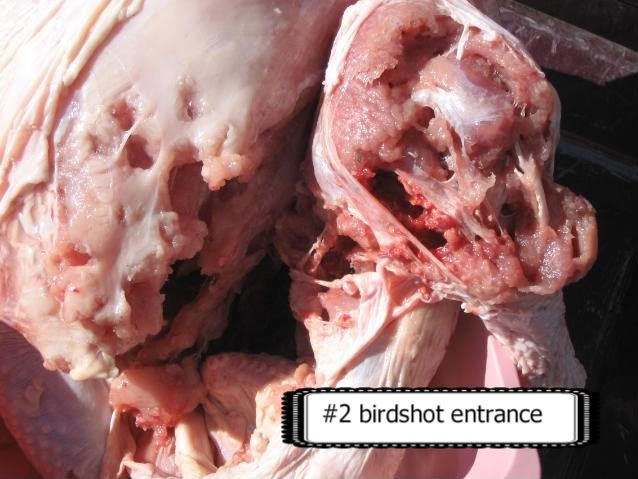
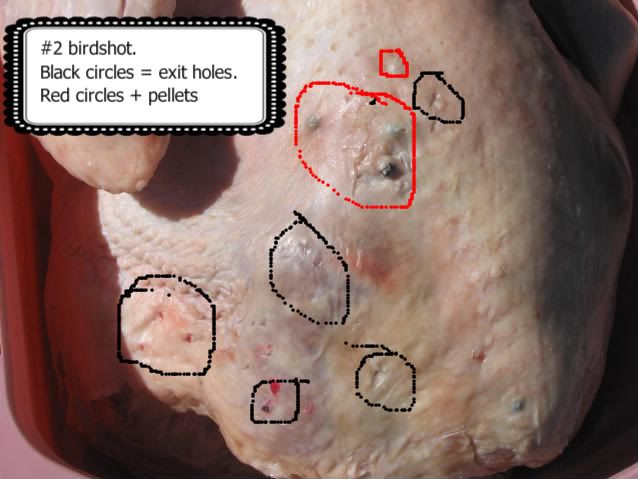

The #2 birdshot did very well as far as I'm concerned. Because of the clothing, it was difficult to tell exactly where the breast was and we missed the center a little bit but the #2 made a very impressive entrance by severing a leg and in turn causing a gaping entrance wound. Pretty much all the shot went all the way through, even after going through the leg and bone. Some of the shot exited and large portion of it stopped right under the skin on the off-side. I have no doubt that the over-whelming majority would have exited had we been 2 yards closer. This load rolled the turkey end-over-end off the table.


__________________
The #4 buck also did well but I expected a little better penetration. The hole made by the main shot column (top hole) was about an inch around and was encircled by 7 pellets that left the main column. The lower hole was made by the wad. This load did quite a bit of damage but it appeared that only about 3/4 of them exited. One pellet was found just under the skin and 4 more poured out when we undressed the turkey. There is no doubt that it all would exited had we been just a tad closer. The turkey did not leave the table.
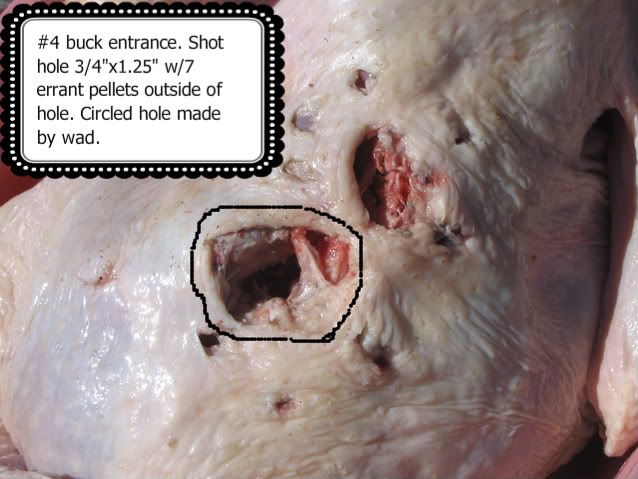
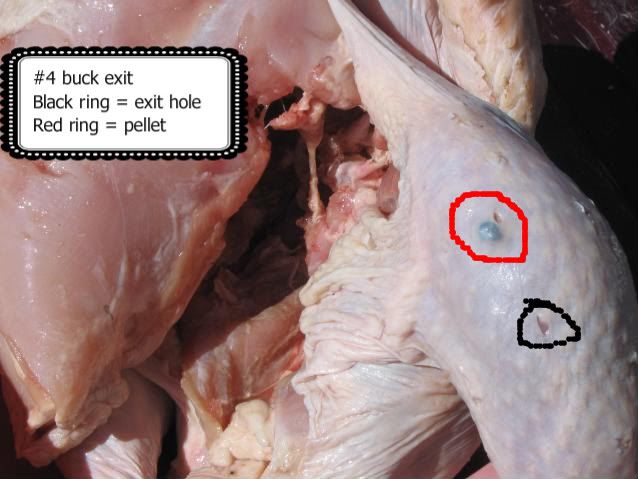


__________________
100% of the 00 buck penetrated completely. The entrance hole was about ¾"x1" with no stray pellets. The damage inside was extensive. We opened it up a little more to look for pellets and found none. I think we would have had 100% exit even if we had moved back 3, maybe even 5 yards farther. Since we had total penetration, we started looking for the pellets. We found where they hit the dirt bank 4 yards behind the table and dug up a couple of them 7" deep. From the way they are deformed, they hit the dirt pretty hard. No other pellet of any size showed much deformation just from the turkey. The turkey slid off the table but not nearly as dramatically as one would have expected due to the total penetration. The reason it slid off the table was because of the force of the amount tissue that left the turkey being propelled into the clothing that the turkey was dressed in.
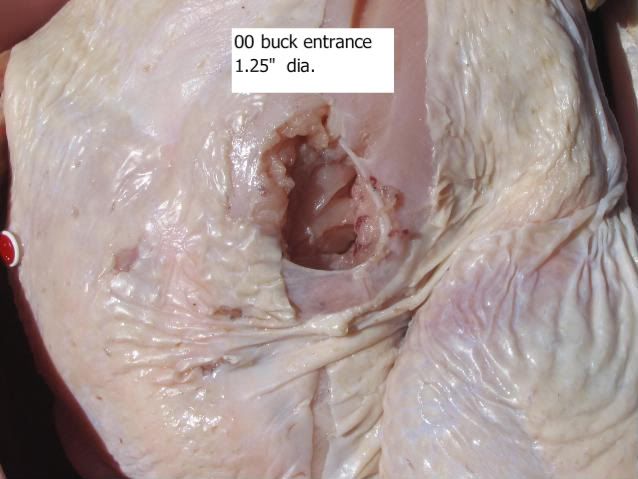
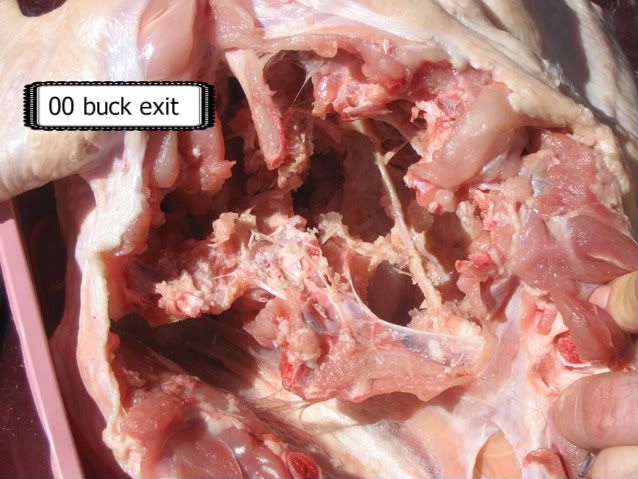
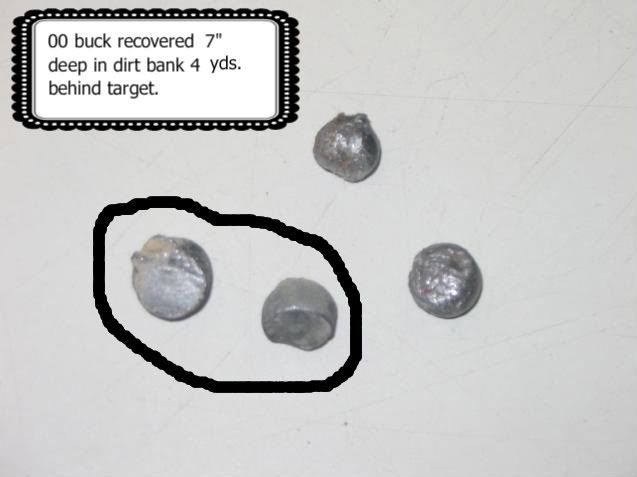
This test just confirmed my thoughts on this subject. While #7½ shot is far from optimum, I think it would work fine in the majority of cases. I'd a hell of lot rather have that than a .380. The way the bird left the table indicated that all of the energy was absorbed by the body even if internal damage wasn't as much as the others. The #2 did just what I had hoped and expected. Almost total penetration and 100% energy transfer which was apparent by the way the turkey was rolled off the table. The danger of over-penetration was minimized while offering good terminal performance. The #4 buck also did well with more damage to the inside than the #2 but less energy transfer because most of the shot exited. This was the only bird that didn't leave the table. The 00 with total penetration did a lot of damage with a LOT of danger behind the target. If those pellets hit hard enough to deform and go 7" deep into soil, there is much concern for me in the home. I'm with everyone else as far as the effectiveness of heavier buck but I am very comfortable with a small sacrifice in terminal performance for the peace of mind that I am not sending .33 caliber lead balls into the next room or trailer house or apartment addressed to whom it may concern..



This test just confirmed my thoughts on this subject. While #7½ shot is far from optimum, I think it would work fine in the majority of cases. I'd a hell of lot rather have that than a .380. The way the bird left the table indicated that all of the energy was absorbed by the body even if internal damage wasn't as much as the others. The #2 did just what I had hoped and expected. Almost total penetration and 100% energy transfer which was apparent by the way the turkey was rolled off the table. The danger of over-penetration was minimized while offering good terminal performance. The #4 buck also did well with more damage to the inside than the #2 but less energy transfer because most of the shot exited. This was the only bird that didn't leave the table. The 00 with total penetration did a lot of damage with a LOT of danger behind the target. If those pellets hit hard enough to deform and go 7" deep into soil, there is much concern for me in the home. I'm with everyone else as far as the effectiveness of heavier buck but I am very comfortable with a small sacrifice in terminal performance for the peace of mind that I am not sending .33 caliber lead balls into the next room or trailer house or apartment addressed to whom it may concern..
__________________
In Liberty,
Cope Reynolds (Desertscout)
Southwest Shooting Authority of Arizona
Listen to Cope live on The Shooting Bench Mon thru Fri, 8 to 9pm Pacific/11pm to midnight Eastern
"The Shooting Bench" Podcast: The Shooting Bench
Colts and Kimbers are what you show your friends.
GLOCKS are what you show your enemies!